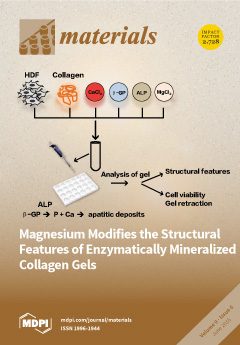This study investigated the colorimetric properties of different veneering materials on core materials. Standardized specimens (10 mm × 10 mm × 1.5 mm) reflecting four core (polyetheretherketone (PEEK), zirconia (ZrO
2), cobalt–chromium–molybdenum alloy (CoCrMo), and titanium oxide (TiO
2); thickness: 1.5
[...] Read more.
This study investigated the colorimetric properties of different veneering materials on core materials. Standardized specimens (10 mm × 10 mm × 1.5 mm) reflecting four core (polyetheretherketone (PEEK), zirconia (ZrO
2), cobalt–chromium–molybdenum alloy (CoCrMo), and titanium oxide (TiO
2); thickness: 1.5 mm) and veneering materials (VITA Mark II, IPS e.max CAD, LAVA Ultimate and VITA Enamic, all in shade A3; thickness: 0.5, 1.0, 1.5 and 2 mm, respectively) were fabricated. Specimens were superimposed to assemblies, and the color was determined with a spectrophotometer (CieLab-System) or a chair-side color measurement device (VITA EasyShade), respectively. Data were analyzed using three-, two-, and one-way ANOVA, a Chi
2-test, and a Wilson approach (
p < 0.05). The measurements with EasyShade showed A2 for VITA Mark II, A3.5 for VITA Enamic, B2 for LAVA Ultimate, and B3 for IPS e.max CAD. LabE-values showed significant differences between the tested veneering materials (
p < 0.001). CieLab-System and VITA EasyShade parameters of the different assemblies showed a significant impact of core (
p < 0.001), veneering material (
p < 0.001), and thickness of the veneering material (
p < 0.001). PEEK as core material showed comparable outcomes as compared to ZrO
2 and CoCrMo, with respect to CieLab-System parameters for each veneering material. The relative frequency of the measured VITA EasyShade parameters regarding PEEK cores also showed comparable results as compared to the gold standard CoCrMo, regardless of the veneering material used.
Full article






